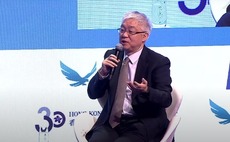
Q&A: Xpeng's Brian Gu
Brian Gu, vice chairman and president of Chinese electric vehicle manufacturer Xpeng, explains how the private equity-backed company is trying to stand out in a competitive and fast-changing market
Xpeng Motors is led by Xiaopeng He, who previously created online browser UCWeb, which was acquired outright by Alibaba Group in 2014. A longstanding fan of Tesla, He decided to invest in the electric vehicle space in China, interviewed several start-ups, and ended up backing a team that spun out from Guangzhou Automotive Industry Group. The company became known as Xiaopeng Motors, or Xpeng, in honor of its new backer. Xpeng's debut vehicle, the G3 crossover SUV, went into mass production last year. Its P7 coupe was unveiled last month.
Q: What is the government doing to encourage the development of the EV industry?
A: The government is not only mandating the industry to be more energy efficient through more stringent emissions standards, but it is also introducing policies like license plate restrictions, modifications to existing subsidy schemes, and parallel credit. In addition, a huge amount of money is being spent on building the infrastructure for charging.
Q: Aren't subsidies on the way out?
A: They are going away, it's a matter of how quickly. My expectation is by 2021, subsidies will be completely gone. Consumer subsidies are counterproductive in supporting the long-term development of the industry. First, they encourage OEMs [original equipment manufacturers] to target collecting subsidies, not come up with the best products. Second, subsidies create cashflow burdens for smaller companies as they are only given out two or three years after you sell the car, so you must bear the cash burden upfront. Subsidies will be replaced by other measures – such as tax breaks or support for building better charging infrastructure – that will be better for us. Also, without subsidies, a lot of lower end EV players will disappear because they are not building competitive products.
Q: What is the competitive environment like?
A: There are a lot of names out there, but only three have a production model car on the street that is being sold to consumers: Xpeng, Nio and WM Motor. Others are still in the concept stage. From a concept car to a production car – from a car that is in the showroom to one used for every day driving – is a huge effort. It requires a massive infrastructure build-out in terms of supply chain and factory management, production, quality control, sales, services, and charging facilities. I think 90% of the new EV players will not make it because they won't be able to get to that stage or they will be absorbed by a traditional OEM. Some companies are trying to build lower-cost vehicles, but that is unlikely to be a sustainable advantage in the long run. No matter how low your costs, you aren't going to be able to compete with traditional OEMs that have massive volume and better relationships with suppliers.
Q: How much variety is there in terms of price points?
A: Nio is the luxury segment, priced at RMB400,000-500,000 ($60,000-75,000). We are RMB150,000-200,000, WM is RMB120,000-170,000. There is some overlap at the low end and then the traditional OEMs are very competitive in the lower end segment. Beijing Auto prices at RMB100,000 or lower, and then with BYD and Geely it could be lower or higher than us.
Q: How does Xpeng differentiate itself through technology?
A: How do you define a smart car? I put this question to several opinion leaders in the industry last year and they all had different answers. In my mind, there are three dimensions. One, does the car have a deep learning capability? If you're using it every day with voice and facial recognition, the car gets to know you, it can make recommendations to improve the driving experience. Two, can the car be upgraded OTA [over-the-air] in everything? A lot of the time, when EV players talk about OTA, they mean the applications on the screen. But can you do an OTA update of the autonomous driving capabilities or the drive train? Three, what is the level of autonomous driving?
Q: What progress is being made on autonomous driving?
A: In one or two years, we think we will have level-three autonomy, where you can drive on highways and free your hands. We have probably one of the largest autonomous driving teams of all OEMs in China and we are the only one with our autonomous driving technology in our production car. The hardware – our SEPA (smart electric platform architecture) – is already embedded in our production models, and we will gradually increase the capabilities through OTA. There are other brands that charge customers extra to incorporate the sensors that take on future autonomous driving. The models we sell have the sensors laid out, it's a matter of how you get the software to different stages of development.
Q: Autonomous driving aside, how smart can your cars become?
A: We already have cameras that recognize you, check your heart rate, give you a warning when your eyes are distracted, and then you can use your voice to control everything. The cars will become smarter and better. There will be more logic, more knowledge of your preferences – for example, what song you want to listen to in morning traffic, whether you want to get coffee on the way, your buying behavior. The car will have more capabilities to serve you.
Q: To what extent does Tesla represent a competitive threat?
A: Having Tesla come to China with a better product is a good thing – it stimulates consumer interest and it helps develop supply chains. We are not too worried about the competition. Our price point is less than half that of their cheapest model. Even with local production and price reductions, the brand appeal will be different. Price is not our main differentiating factor. What makes us stand out is our smart features that are tailored for local road conditions and driver behavior in China.
Q: What about the internet-enabled car-sharing platforms like Didi Chuxing?
A: We believe that to have the best product and user experience you must design the software and hardware together. That way, you can build an ecosystem that covers all customer touch points. A car isn't like a phone. It is very complicated; it has a lot of controls. The opportunity in the sharing space is immense. We are developing better autonomous driving reliability and a better driver-vehicle interface with continuous OTA upgradability. That's a clear competitive advantage against any ride-hailing operator. Our goal is to become a smart mobility company and we believe ultimately there will be convergence.
Q: Why does there tend to be a relatively long lag time in between orders being placed and being fulfilled?
A: Deliveries take time: the car must be produced, go through a stringent quality control process, be sent to delivery centers, and get license plates. The procedure for filing subsidy claims is complex and then if you need financing, it takes even longer. If you bought a G3 today, you wouldn't receive it until the second half of this year. We are looking at 10,000 deliveries by the end of July and 40,000 by the end of 2019.
Q: What is your approach to distribution?
A: We have over a dozen stores in Beijing, Shanghai, Shenzhen, and Guangzhou, and we want to expand to over 100 by the end of the year. Our stores in city centers are cost-effective – 250 square meters, not those 2,000 sqm club house-style centers. We have delivery centers and service centers on the outskirts of cities. We do a lot of online-to-offline conversion.
Q: How big is your charging network?
A: We are building our own proprietary super-charging stations. We have a few dozen now, and we expect to reach a couple of hundred by the end of this year and 1,000 within three years. The government provides subsidies to third-party charging companies, but most of the infrastructure is built by state-owned companies like State Grid Corp. of China and China Southern Power Grid. They are putting charging stations along highways.
Q: What are the major growing pains for EV companies in China?
A: When young companies build up, they need a lot of management capabilities, industry expertise, and infrastructure. Getting that is a challenge. It is also difficult to make the right business decisions in terms of which products to push and when to push them, when to spend the money, how you build a brand. It's a new space, so there are no success stories, nothing to learn from. You rely on your best judgment and common sense.
Q: Xpeng raised approximately $600 million in its last funding round. Where is the money going?
A: The majority is going into the car itself – R&D and production. When you get into volume production and delivery, that is when real funding is required. We look at all our options in terms of public and private markets, and we think about how to get funding in the most efficient way possible.
Latest News
Asian GPs slow implementation of ESG policies - survey
Asia-based private equity firms are assigning more dedicated resources to environment, social, and governance (ESG) programmes, but policy changes have slowed in the past 12 months, in part due to concerns raised internally and by LPs, according to a...
Singapore fintech start-up LXA gets $10m seed round
New Enterprise Associates (NEA) has led a USD 10m seed round for Singapore’s LXA, a financial technology start-up launched by a former Asia senior executive at The Blackstone Group.
India's InCred announces $60m round, claims unicorn status
Indian non-bank lender InCred Financial Services said it has received INR 5bn (USD 60m) at a valuation of at least USD 1bn from unnamed investors including “a global private equity fund.”
Insight leads $50m round for Australia's Roller
Insight Partners has led a USD 50m round for Australia’s Roller, a venue management software provider specializing in family fun parks.








